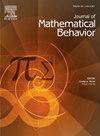Student justifications regarding converse independence
IF 1.7
Q3 EDUCATION & EDUCATIONAL RESEARCH
引用次数: 0
Abstract
This paper presents five categories of undergraduate student justifications regarding the question of whether a converse proof proves a conditional statement. Two categories of justification supported students’ judgments that converse proofs cannot so prove, which is the normative interpretation. These normative judgments depended upon students spontaneously seeking uniform rules of proving across various conditional statements or assigning a direction to the statements and proof. The other three categories of justification supported students to affirm that converse proofs prove. Students offering these justifications do so because they do not perceive any distinction in meaning between a statement and its converse when both are true. The rationality of these nonnormative justifications suggests the need for further work to understand how we can help students understand the normative rules of logic.
学生对反向独立的论证
本文提出了五类本科生关于逆向证明是否证明条件命题的论证。两类证明支持学生的判断,逆向证明不能证明,这是规范性解释。这些规范性判断依赖于学生自发地在各种条件陈述中寻求统一的证明规则或为陈述和证明指定方向。其他三类论证支持学生肯定反向证明证明。提出这些理由的学生之所以这样做,是因为当一个陈述和它的反面都是正确的时候,他们没有察觉到两者在意义上的任何区别。这些非规范性论证的合理性表明,我们需要进一步研究如何帮助学生理解逻辑的规范性规则。
本文章由计算机程序翻译,如有差异,请以英文原文为准。
求助全文
约1分钟内获得全文
求助全文
来源期刊

Journal of Mathematical Behavior
EDUCATION & EDUCATIONAL RESEARCH-
CiteScore
2.70
自引率
17.60%
发文量
69
期刊介绍:
The Journal of Mathematical Behavior solicits original research on the learning and teaching of mathematics. We are interested especially in basic research, research that aims to clarify, in detail and depth, how mathematical ideas develop in learners. Over three decades, our experience confirms a founding premise of this journal: that mathematical thinking, hence mathematics learning as a social enterprise, is special. It is special because mathematics is special, both logically and psychologically. Logically, through the way that mathematical ideas and methods have been built, refined and organized for centuries across a range of cultures; and psychologically, through the variety of ways people today, in many walks of life, make sense of mathematics, develop it, make it their own.
 求助内容:
求助内容: 应助结果提醒方式:
应助结果提醒方式:


